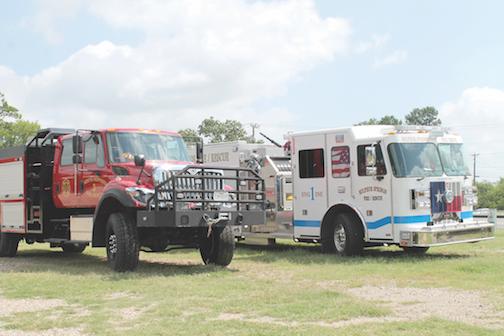Hopkins county aces simulated tornado response
Hopkins County emergency management was put to the test Friday, and according to auditors monitoring their progress, they passed with flying colors.
The simulated disaster, a tornado that hit Gerald Prim Stadium, was called in over communications at 10:04 a.m. with unknown injuries.
In total, auditors found the total time elapsed from when emergency crews arrived on scene to when the last “victim” (a volunteer pretending to be injured) was loaded into the ambulance was 10:14-10:47 a.m.
Auditors expressed they were impressed it only took Hopkins County police, fire and emergency personnel 33 minutes to completely clear a natural disaster scene.
Disaster drill auditor Ronnie Bass said 11 “victims” were located on the end of the football field in the parking lot near Highway 11, and the departments handled triage of these volunteers within nine minutes.
“I found no major flaws at all,” Bass said. “The departments were working well, and nobody seemed to stumble.
“To me, if that had been a real incident, there would be no critique.”
Auditor Chad Graves monitored the end of the football field at the far end of the parking lot. The fire department responded to this part of the emergency, he said, and were able to triage volunteers within eight minutes.
“The only hiccup was with EMS; they got a call right in the middle of it and kind of threw a kink in it,” Graves said, referring to a real life call for a sick person that took responders away from the drill.
Auditor Quincy Blount noted he clocked the total time at 40 minutes and that he was also impressed, given that two junior police officers were shadowing the drills that day.
When asked if they had purposely put extra staff on shift that day to attempt to make the drill go faster, fire chief Andy Ensley and EMS director Brent Smith stated no, they had not.
Ensley stated they staffed one extra crew to stay behind in case of actual emergency during the drill, but otherwise no extra staff was brought in.
In fact, Ensley stated, “When the call went out and we specified that this was a drill, I’m sure they were thinking, ‘well we’d rather stay here and clean up our own yards.’”
Ensley referred to the fact that the day previous, Hopkins County underwent severe storms that lead to several downed trees and power lines across the county, to which emergency crews were busy responding.
Tira, Arbala and North Hopkins were the departments were able to spare a crew to respond to the drills that day, Endsley said.
Auditor Blount praised SSPD Lieutenant Brad Horton and Corporal Chris Rosamond for walking the scene, from the football stadium to the multipurpose building, to make sure there were no additional injuries that had not been discovered during the main drill.
“That’s crucial,” Graves said. “We’re not there to render aid. We’re there to say, ‘we’ve got more.’”
According to Smith, the future of emergency response will lie with coordination between counties.
“There’s a ton of assets around here,” Smith said. “All we have to do is look into them. Dive teams, regional hazmat teams. I think it’s going to be a big thing, not only city and county, if we work together.”



